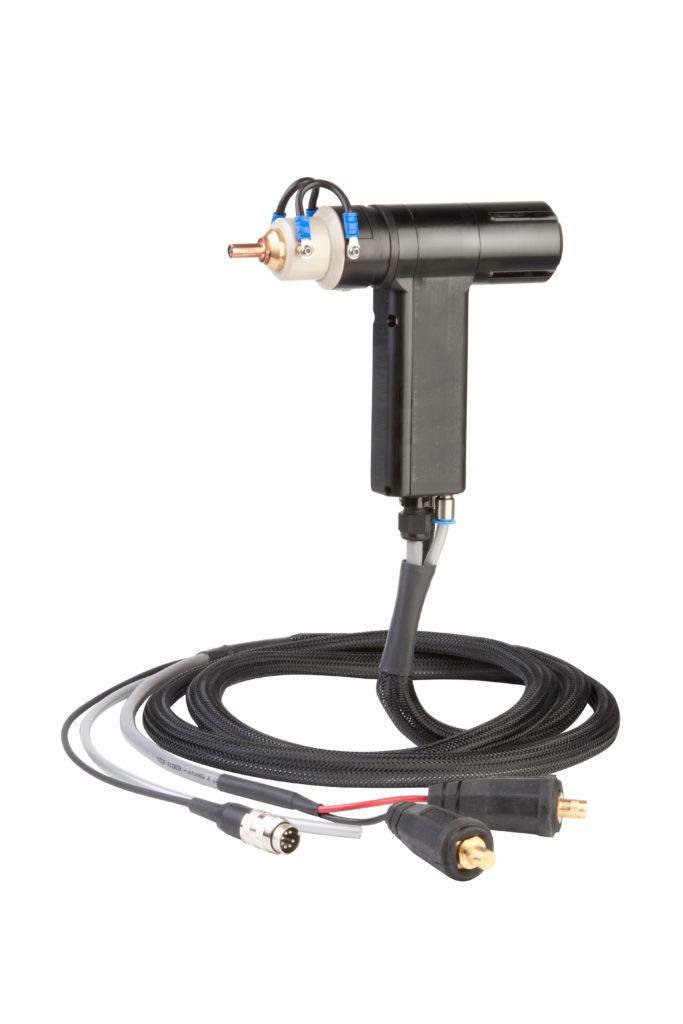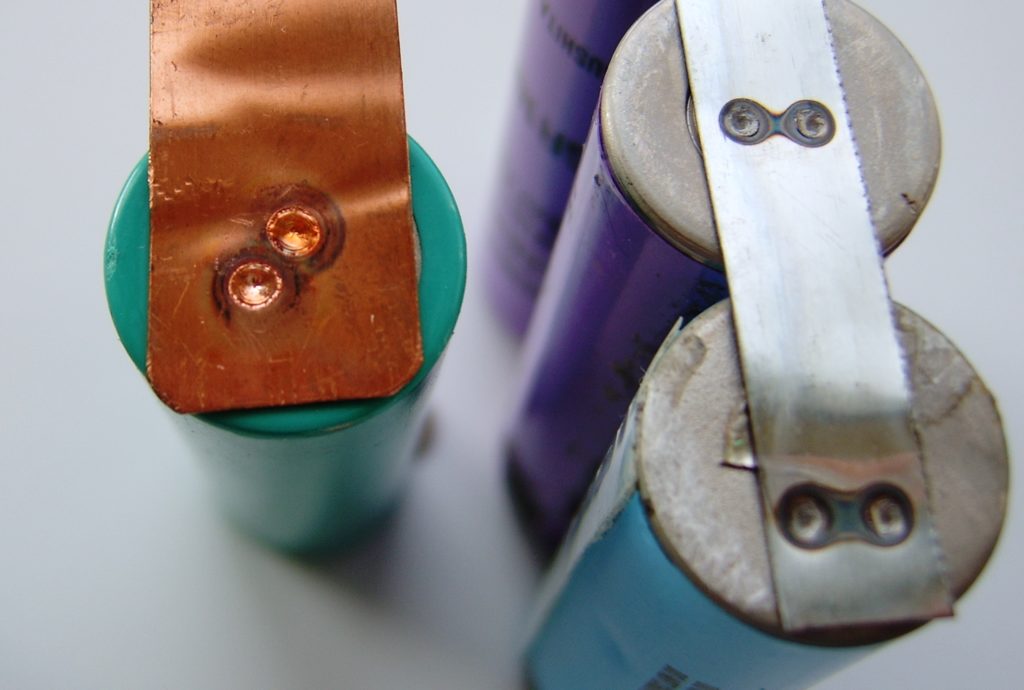New TIG welding torch technology enables rapid design evaluation of battery pack concepts. James Tod reports
Improving battery technology is necessary to respond to the global focus on electric vehicle (EV) technology.
One way of improving battery pack performance is by replacing existing nickel battery tabs with copper material.
Unfortunately, it has been difficult and/or expensive to weld copper using traditional methods.
Now, a new touch retract tungsten inert gas (TIG) welding technology has been developed that allows safer and easy manipulation of battery cans and tab materials in a bench-top, research and development (R&D) environment.
Using typical prototype tooling, the system is especially suitable for R&D on battery pack concepts and assembly, low-medium volume battery pack manufacturing, and battery pack repair/rework applications. Longer term uses include maritime, aviation, energy, and consumer goods.
Battery pack welding for EV market
Market analysis suggests that electric cars will cost the same as gasoline vehicles within eight years, pushing the global EV fleet to 530 million vehicles by 2040.
About 90 gigawatt hours of EV lithium-ion battery manufacturing capacity is currently online, and this is set to rise to 270 gigawatt hours by 2021.
Switching from nickel to copper tabs for battery connections can increase EV battery life by up to 20%, so manufacturers are looking for the most cost-effective technologies to do so. Available battery pack welding technologies include traditional resistance welding, laser welding, and TIG welding.
Resistance welding is considered the standard for welding non-copper electrical components.
Quick, simple, and very low cost, resistance welding has many benefits.
Unfortunately, copper is harder to resistance weld. Resistance welding relies on the inherent electrical resistance in a material to create heat, which melts the metal and creates the bond.
Copper is conductive to electricity, so it does not generate much heat; what heat it does generate is largely directed away from the area.
Laser welding works well for welding copper to tabs, but it can be an expensive solution. In addition to the cost of the lasers themselves, tooling equipment is necessary to hold the parts firmly in place. Because no mechanical force holds the parts together, tooling is required to ensure the proper contact before welding.
The higher cost makes laser welding copper tabs best for high volume manufacturing factory production lines, not lower volume R&D applications.
Micro arc welding is a highly efficient method for generating localised heat. With TIG welding, the operator strikes an arc on an electrode.
Operators point the electrode at the part to be welded, and then use a high voltage to create a spark (similar to lightning) between the electrode and the material. That arc generates quite a bit of heat, which melts the material together and forms a strong bond.
Due to the high voltage used, traditional TIG welding is safer and most effective in machines where there is no physical contact – and when it is in the hands of a skilled operator who can control the arc gap.
Using traditional high voltage TIG welding in R&D applications, hand held assembly, and low volume manufacturing presents health and safety problems.
While those working in these settings may hold a PhD in battery science, they are not likely to be highly skilled TIG welders.
Recently, a new type of touch retract TIG welding torch technology has been developed that does not involve physical contact.
The electrode is pulled back with an electronic solenoid, eliminating the high voltage ignition and making it a lot safer and easier to use.
The touch retract torch is extremely repeatable. It does not require maintaining a given distance – pulling back at the same distance every time. In effect, anyone can create a repeatable weld.
Figure 1 shows the three steps in the touch retract TIG torch process. (Left – approach) The electrode extends below the nozzle, enabling the operator to see where they are placing the weld. (Centre – compression) During the compression step, the operator pushes down on the torch.
A small current detects that the electrode is in contact with the workpiece. (Right – retraction) In the final retraction phase, the electrode retracts, drawing an arc with an intermediate current. When the mechanism is at full travel, the main welding current is applied.
Advantages of the new TIG torch technology for battery pack welding
The new TR-T0016A touch retract torch manufactured by AMADA MIYACHI, was developed primarily for use in battery pack welding for electric vehicle (EV) applications, in which hundreds of small cells are welded together into modules.
In the past, nickel bus bars were used to join up positive and negative terminals, but new designs are seeking to join copper strips to the battery can.
The new touch retract TIG torch welder offers effective welding of copper with relative ease compared to traditional resistance welding techniques.
For hand assembly, touch retract starting is a safer method than high voltage. It also costs less than a typical laser system.
For example, major global automobile manufacturers seeking to weld their own battery packs may opt for a robotic laser system that costs about half a million dollars and is used in an automated production line.
But for those looking to conduct rapid evaluation of battery pack designs or other R&D work, and for production of small volume prototypes, small to medium scale battery pack repair or rework, or even Formula 1 racing teams, the hand held touch retract TIG torch welder is an attractive solution that works well. It can also be a tool for investigating and fixing process issues.
Rather than simply disposing of parts, the touch retract torch can be used to fix loose joints.

Figure 2. AMADA MIYACHI TR-T0016A
Figure 2 shows the new AMADA MIYACHI TR-T0016A, supplied in a plastic carry case, which includes the welding torch fitted with cables, instruction manual, spare nozzle, spare ceramic, spare spring, spare electrode Hex wrench, and spanner.
The flexible nature of the retractable TIG torch allows concepts to be quickly manufactured and tested so it fits well with R&D organizations working on the evaluation and production process design of their battery pack concepts.
The technology offers a high repeatability rate with one weld per second. It also has a narrow (7mm) nozzle and protruding electrode for better weld location control.
While designed for hand use, the touch retract TIG torch can be incorporated into an automated manufacturing line, so it would be appropriate for low-medium volume production applications.

For example, it would be a good option for university spinoffs that have done R&D and are now looking to scale up for production, and want the repeatability of an automated machine.
The new system has been extensively tested for welding typical battery tab materials (copper, nickel, and aluminium, up to a thickness of 0.5 millimetres (mm)) onto 18650 and 21700 battery can material. It can also be used to join other metals, including stainless steel, gold plated stainless steel, and many others.
Figure 3 shows an example of a battery tab welding application.
Safer and cost-effective solution for R&D environments
Offering ease of joining copper strips on a battery and a high repeatability rate, the new lightweight, handheld tool TIG torch can be used for rapid design evaluation of battery pack concepts, small-medium scale manufacturing, and manufacturing scale-up.
Equally good for hand production and rework and automation, the new product features a low voltage arc to encourage operator safety.
James Tod is Amada Miyachi UK.
 Engineer News Network The ultimate online news and information resource for today’s engineer
Engineer News Network The ultimate online news and information resource for today’s engineer





